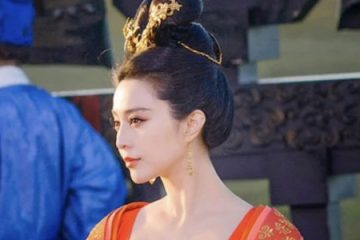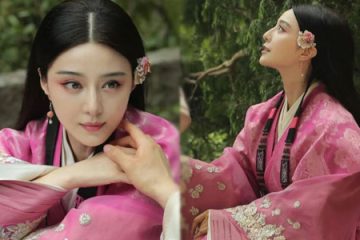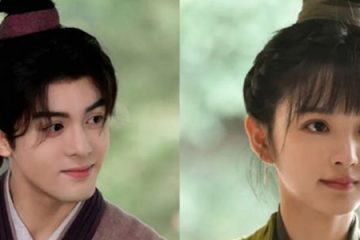Why Are the Sleeves in Ancient Costume Dramas So Enormously Large?

Sometimes, when I see characters in TV dramas wearing clothes with large sleeves while going out for an outing, having a meal, going on a date, getting into a fight… or even sleeping, I feel really awkward. Were all the clothes of the ancient people with large sleeves? How inconvenient it would be to use the restroom! Are the sleeves of ancient costumes in modern TV dramas getting bigger and bigger? The cuffs are so large that a person could actually fit into them!
Ⅰ. How Many Types of Sleeve Shapes Are There in Hanfu?
Although we usually use a phrase to describe the characteristics of Hanfu, which is “loose robes and large sleeves”, loose clothing refers to Hanfu, and large sleeves or wide sleeves mean that the sleeves are broad. However, it should be noted that this is not a universal feature of Hanfu. Instead, it is a characteristic of Hanfu formal attire, used to show the status and position of the wearer, such as the historical large – sleeved robes and official uniforms. Except for ceremonial occasions, people really didn’t wear such large sleeves in their daily lives.

Let’s break down the sleeve styles of Hanfu in a simple and straightforward way. Just by briefly listing them, there are as many as those shown above, and they are applicable to any occasion in our current lives. To put it more simply, for instance, narrow sleeves (upper left in the picture) are suitable for occasions such as daily labor and practicing martial arts. Hanging sleeve (upper right), pipa sleeves (in the middle of the upper part), and straight sleeves (lower left) are appropriate for daily situations where no labor work is involved. Short sleeves (in the middle of the lower part) are ideal for common outerwear and can be matched with various items at home during summer. Moreover, this kind of short sleeves often appear in the style of half-sleeve Hanfu.
Ⅱ. Real Cultural Relics with Large Sleeves

Let’s take an example of real cultural relics. These two pieces are silk Hanfu cultural relics from the Mawangdui Han Tombs: the curved – robe Hanfu and the straight – robe plain silk unlined garment. In the Western Han Dynasty, the unlined garment was also used as an outer or inner garment for formal daily wear. The width of the cuffs is only about 29 centimeters. By comparison, the width of the cuffs of our normal modern fashion clothes is around 10 centimeters, and for slightly looser sleeves, it is about 15 centimeters. Even if we calculate the maximum width, 30 centimeters is only about twice as wide as the current loose sleeves, and it’s not particularly large.
As for the real large sleeves, one type is the large sleeves unearthed from the Southern and Northern Dynasties period. The narrow – arm style in the picture above is at least about one meter wide and was mostly worn by ladies of the nobility, officials, and dancers.

In addition, there is the purple tie – dyed ru (a kind of short coat) collected by the National Museum of Silk and this twisted tie – dyed silk robe. The width of the sleeves is approximately around 40 to 50 centimeters. These are large sleeves that are not overly exaggerated, and people can still take care of themselves in these clothes.

The officials going to court in the TV drama The Princess Royal seem to be wearing large – sleeved clothes similar to the silk robes which are cultural relics.

Another type is the large – sleeved robes that were popular during the Tang and Song dynasties and were also carried forward in the Ming Dynasty. The widest ones can reach 80 to 90 centimeters in width. This kind of large – sleeved robe is generally used as formal attire for grand occasions such as weddings and conferment ceremonies. When wearing such large – sleeved traditional Chinese clothing, there are usually attendants by one’s side, and one has to take off the large sleeves when going to the restroom.
However, attentive netizens have noticed that there is a stitched line on the large – sleeved robe unearthed from the Zhou Family’s Tomb in De’an. It is speculated that this is related to the Song people’s concept of seeking simplicity and convenience. The purpose is to “transform” the large sleeves into narrow sleeves or straight sleeves in a “concealed” way, while still maintaining proper etiquette.

Why are the sleeves in ancient costume dramas made so large? It’s for the sake of creating an otherworldly and ethereal look! It’s to show the status and position of the characters! To make it seem like the characters are walking with a gust of wind, the sleeves should usually be able to catch the wind, and it’s even better if there is a long train. But they really don’t consider the practical use at all. Think about how our ancient people took great pains to simplify complex things, yet now, for the sake of visual effects, in ancient costume dramas, large sleeves are used in almost every situation, without following the usage scenarios and functions at all. That’s why there are so many misunderstandings.


III. What to Do When Large Sleeves Are Inconvenient
After all, except for some ceremonial occasions, people wouldn’t wear such large sleeves that are inconvenient for movement in daily life. However, if you really like the large – sleeved Hanfu sets (after all, the designs are really beautiful), here are some tips that can help you.
1. Use elastic cuffs to tie the sleeves. They look nicer and are sturdier than ordinary rubber bands. They won’t loosen even if you wear them all day long, and they won’t constrict your wrists either. It’s very convenient when you want to have a big meal, like hot pot or barbecue.
The specific operation is as follows: When wearing Hanfu, use an elastic band to tie the cuffs tightly. Then, roll up the cuffs to cover the elastic band. Finally, move the sleeves upwards to a position above the elbows. In this way, no matter how you move, the sleeves won’t slide down.

2. Use a pibo or sleeve supporters (襻膊, panbo). First, place the ropes one above the other behind your back. Then, simply fold the sleeves a bit. Let the upper rope go around the middle of the sleeve, and carry it behind your back. Then pull it out from the shoulder area and tie a knot with the lower rope.



Summary
After all, Chinese intelligent ancestors wouldn’t make things difficult for themselves just because of large sleeves. So, if someone asks you whether it’s inconvenient to wear large – sleeved Hanfu or whether all the clothes in the past had large sleeves, you can just show them this article.
In addition, Hanfu is actually not just one style. Loose robes and large sleeves are just one of them. There are also Hanfu styles that combine short jackets with trousers. If you think this style really affects you too much, then you can just buy other styles. After all, the big family of Hanfu is like a garden full of blooming flowers with various styles.




0 Comments